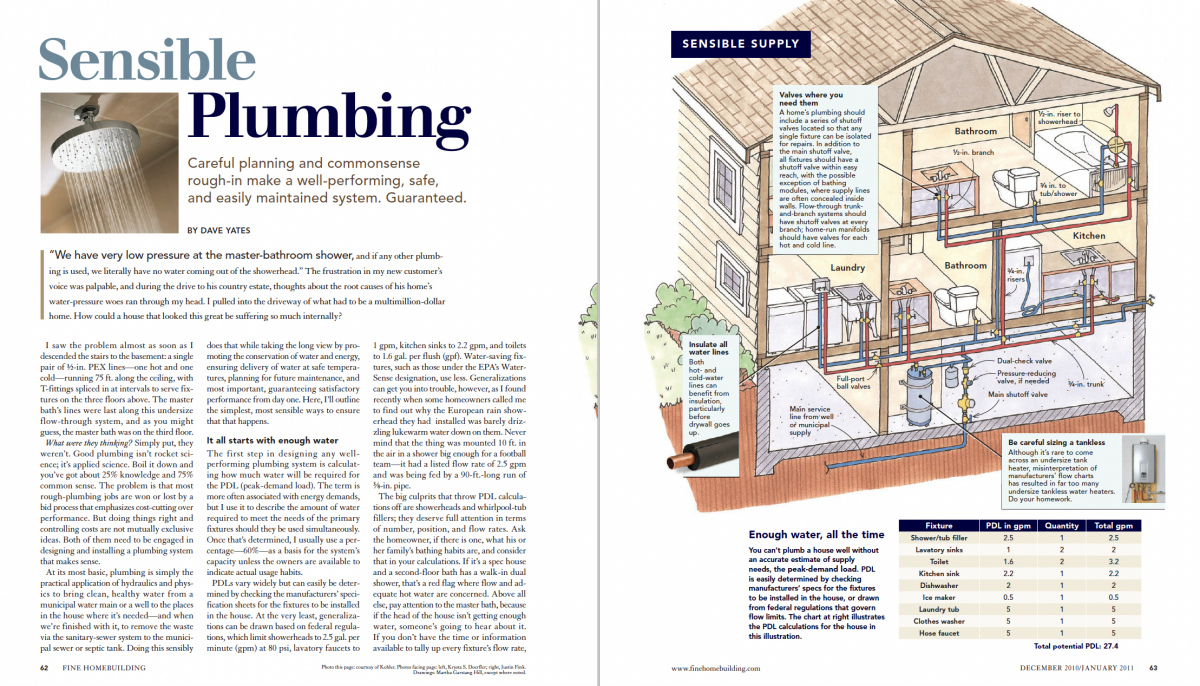Sensible Plumbing
Careful planning and commonsense rough-in make a well-performing, safe, and easily maintained system. Guaranteed.

Synopsis: According to plumber Dave Yates, good plumbing isn’t rocket science; it’s applied science. He also says that it’s possible to control costs and to do things right when plumbing a house. The start to sensible plumbing in a house is calculating peak-demand load (PDL), or the amount of water needed to accommodate the primary fixtures should they be used simultaneously. With an accurate PDL number, you’ll be able to design a system that gets water to where it’s needed, fast and hot. Other important parts of a well-designed plumbing system include a water heater that’s the right size for the house, valves that work properly, good connections to waste lines, trouble-free venting, adequate insulation around pipes in open walls, properly sealed penetrations, and the proper scald-protection steps.
I saw the problem almost as soon as I descended the stairs to the basement: a single pair of ½-in. PEX lines — one hot and one cold — running 75 ft. along the ceiling, with T-fittings spliced in at intervals to serve fixtures on the three floors above. The master bath’s lines were last along this undersize flow-through system, and as you might guess, the master bath was on the third floor.
What were they thinking? Simply put, they weren’t. Good plumbing isn’t rocket science; it’s applied science. Boil it down and you’ve got about 25% knowledge and 75% common sense. The problem is that most rough-plumbing jobs are won or lost by a bid process that emphasizes cost-cutting over performance. But doing things right and controlling costs are not mutually exclusive ideas. Both of them need to be engaged in designing and installing a plumbing system that makes sense.
At its most basic, plumbing is simply the practical application of hydraulics and physics to bring clean, healthy water from a municipal water main or a well to the places in the house where it’s needed — and when we’re finished with it, to remove the waste via the sanitary-sewer system to the municipal sewer or septic tank. Doing this sensibly does that while taking the long view by promoting the conservation of water and energy, ensuring delivery of water at safe temperatures, planning for future maintenance, and most important, guaranteeing satisfactory performance from day one. Here, I’ll outline the simplest, most sensible ways to ensure that that happens.
It all starts with enough water
The first step in designing any well-performing plumbing system is calculating how much water will be required for the PDL (peak-demand load). The term is more often associated with energy demands, but I use it to describe the amount of water required to meet the needs of the primary fixtures should they be used simultaneously. Once that’s determined, I usually use a percentage — 60% — as a basis for the system’s capacity unless the owners are available to indicate actual usage habits.
PDLs vary widely but can easily be determined by checking the manufacturers’ specification sheets for the fixtures to be installed in the house. At the very least, generalizations can be drawn based on federal regulations, which limit showerheads to 2.5 gal. per minute (gpm) at 80 psi, lavatory faucets to 1 gpm, kitchen sinks to 2.2 gpm, and toilets to 1.6 gal. per flush (gpf). Water-saving fixtures, such as those under the EPA’s Water-Sense designation, use less. Generalizations can get you into trouble, however, as I found recently when some homeowners called me to find out why the European rain showerhead they had installed was barely drizzling lukewarm water down on them. Never mind that the thing was mounted 10 ft. in the air in a shower big enough for a football team — it had a listed flow rate of 2.5 gpm and was being fed by a 90-ft.-long run of 3⁄8-in. pipe.
To view the entire article, please click the View PDF button below:







View Comments
Well organized, nicely detailed, and clearly presented. One of the best guides I've read in some time.
I wish I'd had this about 37 years ago. Of course some of it might not have made much sense (PEX what?) but it really helps to think about what causes problems and how to do it right.